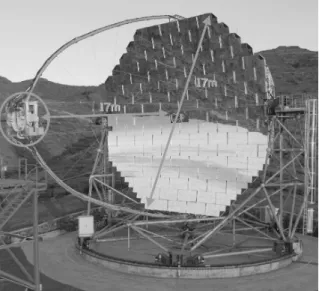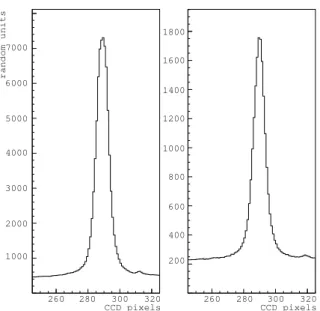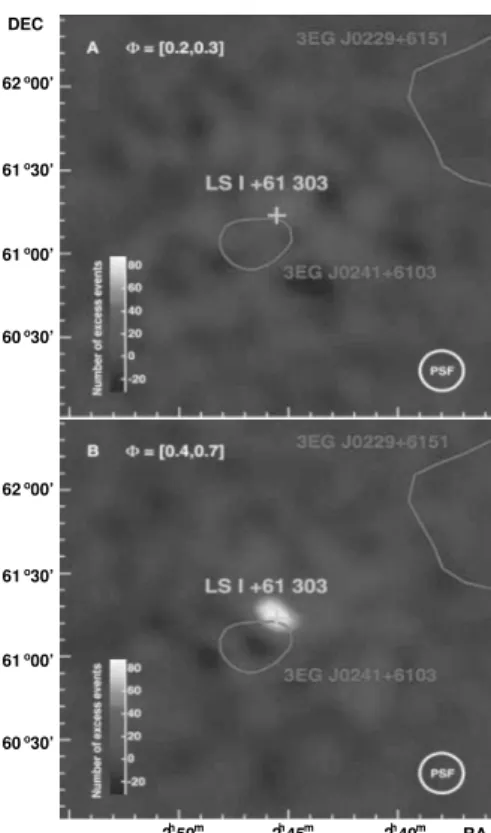A. Biland for the MAGIC Collaboration
aInstitute for Particle Physics, ETH Zurich, CH-8093 Zurich, Switzerland biland@phys.ethz.ch
bhttp://wwwmagic.mppmu.mpg.de/collaboration/members/index.html
MAGIC is the largest of the new generation of Imaging Air Cherenkov Telescopes and has started regular data-taking end of 2004. In this report I will give an overview about the status of the experiment and ongoing upgrades, as well as the already rich harvest of galactic and extragalactic data taken so far.
1. INTRODUCTION
1.1. Very High Energy Astronomy
Almost 100 years after the detection of Cos- mic Rays (CR) by Victor Hess, the origin and ac- celeration processes of these high energetic parti- cles are still not understood. CR consists mainly of protons and other ions, but the omnipresent galactic and extragalactic magnetic fields do not allow to trace the observed charged particles back to their origin. The lifetime of neutrons is too short, and since the sensitivity of actual neutrino- telescopes is far too low, the only remaining parti- cle that can be used to investigate the CR sources are Very High Energy (VHE)γ-rays that are pro- duced from higher energetic CR particles.
During the past 50 years, a lot of effort has been put into the development of more and more sensitive detectors to search for VHEγ-ray sources. With the actual generation of ground based Cherenkov-Telescopes (CT) and the up- coming launch of the GLAST satellite, there ex- ist now detectors that for the first time allow not only to search for sources, but also to do detailed investigations of individual objects in the sky. Es- pecially the successful operation of the H.E.S.S.
and MAGIC telescopes in the past three years has drastically improved our knowledge of the sky in VHE. Among the identified VHE-γ emitters are many different astrophysical objects like Su- pernova Remnants (SNR), Pulsar Wind Nebulae (PWN), Micro-Quasars (µQ) and Active Galac-
tic Nuclei (AGN). Since VHE-γ emission most probably indicates CR-acceleration, it seems that many different types of sources contribute to the CR population.
1.2. Imaging Air Cherenkov Technique Since the earth’s atmosphere is not at all trans- parent toγ-rays, there exist only two possibilities to observe them:
a) use satellites, or
b) use the atmosphere as a calorimeter.
Because of limited size and weight for the de- tectors, satellite based observations are most effi- cient for energies lower than few tens of GeV. For higher energies, ground based detectors are more efficient. Additionally, while satellites are ideally suited to monitor the full sky, the excellent sen- sitivity of CTs allows far better investigations of transient phenomena.
A VHE-γhitting the atmosphere does produce an electromagnetic air shower, consisting mainly of e−, e+ and γ. While most of these particles are absorbed very soon in the atmosphere again, thee−ande+are relativistic and emit Cherenkov light within a narrow cone of ≈1◦ during their short existence. This almost uniformly illumi- nates on ground a region of more than 104 m2 with a photon density depending on the energy of the primaryγ. A CT located anywhere in this illuminated region can detect the shower. There- fore, the size of the reflector of the telescope does not influence the active area of the detector. But
1
a larger reflector allows to collect sufficient pho- tons to observe weak showers from less energetic primaryγ.
The key problem for a CT is not to detect the showers, but to distinguish them from the far more abundant showers produced by charged CR particles. Since hadronic air showers have in average a somewhat different shape than electro- magnetic air showers, the so called Imaging Air Cherenkov Technique (IACT) allows to distin- guish between them[1]: using a fast, fine-grained camera made of photo-multiplier tubes (PMT) al- lows to take images of the showers that (statisti- cally) show differences between hadronic and pho- tonic air showers (Fig. 1). While this technique has proven to be very successful for γ-energies
≥ 100 GeV, the differentiation becomes much more difficult at lower energies.
Figure 1. Examples of shower pictures: the top panel shows aγ-candidate, while the bottom panel shows a hadronic shower
1.3. The MAGIC Telescope
The Major Atmospheric Gamma-ray Imaging Cherenkov (MAGIC)[2,3] telescope is built and operated by≈150 physicists from 18 institutions in 9 countries. At the moment, it is a single dish experiment located on the Roque de los Mucha- chos on the Canary Island La Palma at an alti- tude of ≈2200 m a.s.l. The construction started in 2001, and in October 2003 the telescope was ready for commissioning. Regular data-taking started in October 2004, but many hours of data taken during the commissioning phase are also included in the analysis.
MAGIC is currently the largest of the new generation CT in operation. Its parabolic shaped reflector has a diameter of 17 m, resulting in a total mirror area of 234 m2 formed by 964 Al-mirrors. The PMT-camera is mounted in a distance of 17 m from the mirror and consists of 576 PMTs, resulting in a field of view of 3.5◦ (Fig. 2).
Figure 2. The MAGIC telescope on the Roque de los Muchachos on the Canary Island La Palma
Main goal of the MAGIC design was to reach low energy threshold while keeping the total weight as low as possible: this makes faster ro- tation of the telescope possible, allowing to react on e.g. GRB alarms and start observations typ- ically within 20 seconds. To reach this, several
novel techniques have been developed and inte- grated into the MAGIC telescope.
The support structure of the reflector consists of a space frame made from carbon fiber epoxy tubes. This results in a very strong, but not very rigid structure. Therefore an Active Mirror Con- trol (AMC) system[4], consisting of 494 computer controlled stepping motors and ball-bearing spin- dles as well as 247 guidance lasers, is added to correct for deformations of the dish under vary- ing gravitational load, camera sagging and other effects. After some initial problems, the AMC is now working well within the design parameters and keeps (without any manual interaction) the good optical quality of the telescope constant over all telescope orientations (Fig. 3).
7000
6000
5000
4000
3000
2000
1000
260 280 300 320 CCD pixels
200 400 600 800 1000 1200 1400 1600 1800
260 280 300 320 CCD pixels
random units
Figure 3. Projections of CCD images from star- images in the focal plane of MAGIC. The left measurement was taken July 8. under a zenith angle of 50◦, while the right one on Nov. 11. un- der a zenith angle of 8◦ (from a different star).
Fitting both peaks (and many other measure- ments) gives same result, proving that AMC is keeping the optical quality of MAGIC constant over tima and all zenith angles.
The mirrors are made of a lightweight compos-
ite aluminum structure[5]. The spherical shape of the front side was obtained by diamond milling.
To approximate the parabolic shape of the dish, the radius of the spherical shape of individual mirror-tiles was optimized depending on where the mirror is to be mounted in the telescope. Usu- ally, four mirrors are grouped together and ad- justed by two AMC actuators.
The central part of the camera consists of 397 PMTs of 0.1◦, while 180 PMTs of 0.2◦ are used in the outermost rings. The tubes have a semi- spherical entry window and are equipped with light guides to minimize the dead area between PMTs. Special coating of the entrance windows significantly increases the quantum efficiency and extends the sensitivity in the UV band (Fig. 4)[6].
30 25 20 15 10 5
250 350 450 550 650
Wavelength [nm]
Coated PMT Non−coated
QE [%]
Figure 4. Quantum efficiency of a PMT type ET9116A (as used in MAGIC) before and after coating
The PMTs have only 6 dynodes and are op- erated at rather low gain, allowing to take data also during conditions with rather strong moon light. This allows to extend the data taking time by about 50%. To keep the total weight of the camera low, the readout electronics is installed
in the counting house. To preserve the signal in- tegrity during the transmission along the 175 m long cables, an optical transmission of the analog signals is used. In the counting house, the signal is split into a programmable trigger and into the data acquisition system, consisting of one FADC, operating at 300 MSamples/s, per PMT.
The typical trigger rate during standard oper- ation is approximately 250 Hz.
The actual performance reached by the MAGIC telescope is:
- angular resolution: ≈0.1◦
- position determination for point-like source: 2´
- repositioning to any orientation: <40 s (with reduced motor power)
For small zenith angles, we reach:
- energy threshold (trigger): ≈50 GeV
- energy resolution: 30% @100GeV, 20% @1TeV - flux sensitivity (5σ in 50 h): 2.5% of Crab flux Additional information about MAGIC can be found at http://wwwmagic.mppmu.mpg.de/
2. SELECTED RESULTS 2.1. Galactic Sources
After taking into operation a new telescope, one of the first goals is of course to under- stand its performance and check the calibra- tion. Therefore, several known VHE sources had been observed and analyzed. These included the well known Crab nebula, but also the recently found SNRs HESS J1813-178 and HESS J1834- 087 (W41). Both measurements have confirmed these sources as VHE emitters and showed ex- cellent agreement between the MAGIC measure- ments and published data, without any indication for systematic deviations[7,8].
One very interesting region to look for VHE-γ is the Galactic Center: it does not only contain several astrophysical objects that could work as cosmic accelerators, but there is also the hypo- thesis to see VHE-γ originating from Dark Mat- ter annihilations. Since MAGIC is positioned on the Canary Islands at an altitude of N 28.8◦, it can observe the GC only under very large zenith angles>58◦, resulting in an energy threshold of
>700 GeV. Observations performed in November
2004 and summer 2005 confirm a point-likeγ-ray source with a flux of about 10% of Crab at 1 TeV, spatially consistent with Sgr A∗ as well as Sgr A East. The energy spectrum is well described by an unbroken power low with index α=−2.2 up to an energy of ≈15000 GeV[?, GC] No indica- tion for flux variability has been found. This is in excellent agreement with the earlier results from H.E.S.S. and does make Dark Matter annihila- tion as main source of the VHE γ-radiation very improbable.
A galactic VHE source detected by MAGIC is LS I +61 303. This binary system has been observed during 54 hours (after discarding bad weather data) between October 2005 and March 2006 and clearly shows variable γ-ray emission (Fig 5)[10]. During observations around peri- astron (orbital phases 0.2 – 0.3), no VHE γ- ray could be found, while observations at orbital phases 0.4–0.7 showed a flux from a point-like source in excellent spatial coincidence with LS I +61 303 of about 15% of the Crab flux and a spectral index of ≈ −2.6. Further observations are going on, to clarify if the emission is periodic.
Additionally, it is not yet clear if the emission is µQ-like (i.e. coming from the relativistic jet of the binary system) or PWN-like (i.e. interaction of radiation with the atmosphere of the compan- ion star).
2.2. Extragalactic Sources
The search for VHE γ-ray emission from AGNs is one of the main goals for MAGIC, and most observation time has been spent for this. Besides the observations of the known AGNs Mkn-421, Mkn-501 and 1ES1959+650[11], the first new VHE source discovered by MAGIC is 1ES1218+30.4, a high-frequency peaked BL- Lac object at a redshift z=0.182. During the six nights of observation in January 2005, a sig- nal with 6.4σ significance and a spectrum of FE(E) = (8.1 ± 2.1)10−7(E/250GeV)−3.0±0.4 TeV−1m−2s−1 has been found. No indication of a cutoff is seen in the energy range 100 GeV – 650 GeV, and no flux variation has been observed[12].
At the time of detection, 1ES1218+30.4 had the highest redshift of all known VHE sources.
Another MAGIC detection is Mkn 180, another
62 00’
61 30’
61 00’
60 30’
o
o
o
o
62 00’
61 30’
61 00’
60 30’
o
o
o
o
2 50h m 2 45h m 2 40h m DEC
RA
Figure 5. Observation of LS I +61 303: the top panel shows 15.5 hours of observation close to pe- riastron (orbital phase 0.2–0.3), while the lower panel shows a 10.7 hours observation at orbital phases 0.4–0.7. The crosses mark the position of LS I +61 303, while the contours show the estimated positions of two unidentified EGRET sources. The white circle indicates the Point Spread Function of the MAGIC telescope
high-frequency peaked BL Lac. It was observed during 12.4 hours in March 2006, and found with a significance of 5.5σ. An integral flux above 200 GeV of (2.3±0.7)×10−11cm−2s−1was measured, with a rather soft spectrum with a photon index of−3.3±0.7[13]. The detection of this source has been triggered by an optical outburst, but data are not yet sufficient to conclude a correlation be- tween optical and VHE activity.
A very interesting result is the clear detection of PG 1553+113, a BL Lac with unknown red- shift. A first hint of a signal was found in 8 h
observation in April/May 2005 (and a similar in- dication found by H.E.S.S. soon afterwards). Ad- ditional 12 h of data were taken between Jan- uary and April 2006. Combining both periods and improved analysis results in a 8.8σ detec- tion. The integrated flux between 120 GeV and 400 GeV is found to be rather different with F2005 = (10.0±0.23) and F2006 = (0.37±0.08) in units of 10−11cm−2s−1[14]. The spectral index is about -4.2 for both periods, making this the AGN with the softest spectrum found so far. It is not known if this very soft VHE spectrum results from a very high redshift or if it is an intrinsic feature of this AGN.
Figure 6. Differential energy spectrum of PG 1553+113 measured by H.E.S.S. and MAGIC (combined periods). For comparison, the Crab flux is also shown
Another class of extragalactic objects observed by MAGIC are the enigmatic Gamma Ray Bursts (GRB). Whenever a GRB alarm is indicated on the GCN network and source position and weather condition allow for, the MAGIC tele- scope is immediately turned to the given orien- tation and data taking starts. The first success- ful observation was GRB050713a, where MAGIC data taking started 25 s after the alarm received (in total 40 s after the burst)[15]. Several other GRBs have been observed since then, but none showed an indication for VHE γ-emission. But unfortunately, all GRBs observable by MAGIC
so far had been of very short duration or at ex- tremely high redshift, making the detection of VHE-γvery improbable.
3. CONCLUSION AND OUTLOOK The MAGIC telescope is working well within its design specifications, and several important measurements were successfully executed shortly after starting operation. Data taking and analy- sis is running smooth and will continue for sev- eral years. The analysis ofγ-rays below 100 GeV has proven to be very difficult because of limited γ/hadron separation, and work is going on to test different methods to improve the results. Addi- tionally, the readout system will be improved by using FADCs with a bandwidth of 2 GSamples/s [16], allowing to search for small timing variations in the showers.
Currently, a second telescope (MAGIC-II) of same size is under construction. It incorporates some minor modification in the design based on experience with MAGIC-I, as well as improve- ments possible because of advances in technol- ogy (as larger and lighter individual mirrors and improved readout electronics with far less heat dissipation). We expect to start commissioning of MAGIC-II by the end of 2007 and have both telescopes ready for data taking in stereo config- uration in 2008. Stereo observations will allow to increase the sensitivity by about a factor of two, as well as improving energy and direction resolu- tion.
Together with the excellent performance of H.E.S.S., the soon expected data from VERITAS and the impending launch of GLAST the VHE astronomy is very flourishing.
But it is already clear that investigations on source morphologies and short-scale variability will still be severly limited by sensitivity. One could (and should) significantly improve sensi- tivity and energy coverage by constructing large arrays of CTs. Because of costs, it is obvious that such an installation needs pan-european (or even worldwide) collaboration, and MAGIC and H.E.S.S. already formed combined study groups (including many interested people from outside the community) to discuss different design op-
tions.
4. ACKNOWLEDGMENTS
We would like to thank the IAC for the excel- lent working conditions at the ORM in La Palma.
The support of the German BMBF and MPG, the Italian INFN, the Spanish CICYT, the Swiss SNF, ETH research grant TH 34/04 3, and the Polish MNiI grant 1P0D012028 is gratefully ac- knowledged.
REFERENCES
1. A.M. Hillas, Proc. of the 19th ICRC. La Jolla, 3, 445 (1985)
2. C. Baixeras et al., NIM A 518, 188 (2004) 3. J. Cortina et al., Proc. of the 29th ICRC,
Pune, India, 5-359; astro-ph/0508274 4. A. Biland et al., ”Towards a network of at-
mospheric Cherenkov detectors”, Palaiseau, 2005, 561-565
5. C. Bigongiari et al., NIM A 518, 193 (2004) 6. D. Paneque et al., NIM A 518, 619 (2004) 7. J. Albert et al., ApJ Letters 637, L41 (2006) 8. J. Albert et al., ApJ Letters 643, L53 (2006) 9. J. Albert et al., ApJ Letters 638, L101 (2006) 10. J. Albert et al., Science 312, 1771 (2006) 11. J. Albert et al., ApJ 639 (2006) 761-765 12. J. Albert et al., ApJ Letters 642, L119 (2006) 13. J. Albert et al., ApJ Letters 648, L105 (2006) 14. J. Albert et al., submitted to ApJ
15. J. Albert et al., ApJ Letters 641, L9 (2006) 16. H. Bartko et al., NIM A 548, 464 (2005)


